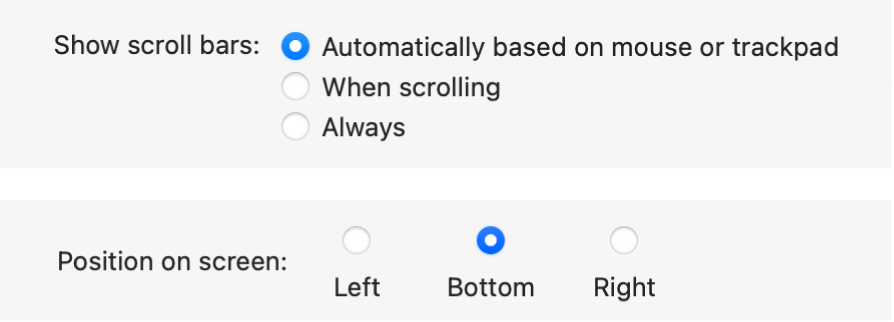
R
- racism, racist language
See Writing inclusively.
- radio button
A labeled circular button used to present a set of mutually exclusive options.

Users select an option. Avoid the term radio button, except in developer materials. You can refer to the option’s label, or to the label used to introduce a group of radio buttons.
Select “Automatically based on mouse or trackpad.”
In the “Show scroll bars” area, select “When scrolling.”
To change the location of the Dock, select an option next to “Position on screen.”
See also checkbox.
- radio-frequency interference
See RFI.
- RAID
Acronym for Redundant Array of Independent Disks, a storage method in which data is distributed among two or more hard disk drives to improve performance and reliability. Storage methods are called levels: RAID level 0, RAID level 1, RAID level 0+1, and so on. OK to shorten to RAID 0, RAID 1, RAID 0+1, and so on. For guidelines about spelling out acronyms, see abbreviations and acronyms.
- Raise to Speak
Note capitalization. An Apple Watch feature.
When Raise to Speak is on, you can raise your wrist and speak your request.
- Raise to Wake
Note capitalization. An iPhone feature.
When Raise to Wake is on, you can wake your iPhone by raising it.
- RAM
Acronym for random-access memory. For guidelines about spelling out acronyms, see abbreviations and acronyms.
- random-access memory
See RAM.
- RAW
A format for image files. Use all caps even though RAW is not an acronym. Don’t use RAW alone; use RAW file, RAW image, RAW setting, and so on.
When you take photos using your camera’s RAW setting, the camera creates a RAW file that retains all the image data captured by the camera.
- ray tracing (n.), ray-tracing (adj.), ray-traced (adj.)
Note hyphenation of adjective forms.
Ray tracing models the properties of light as it interacts with a scene.
Learn how to optimize ray-tracing performance.
Implement ray-traced rendering using GPU-based parallel processing.
- re (prefix)
Close up unless the resulting word creates another word.
reenter, reinstall, reevaluate
re-create (recreate), re-sort (resort)
- Reader
Always capitalize when referring to the Safari feature. Don’t precede with the.
You can use Reader to view articles without distracting ads.
- Reading List
Always capitalize when referring to the Safari feature. Refer to the user’s Reading List as your Reading List.
You can add webpages to your Reading List.
- Read Me
A document that accompanies a product and contains information the user needs to read before installing or using the product.
In user materials, don’t call such documents the Read Me or Read Me file. Instead, use the document’s name enclosed in quotation marks. Call a file “Read Me” only if that’s the actual filename.
- read-only memory
See ROM.
- read/write (adj.)
Note slash, as in read/write memory.
- real time (n.), real-time (adj.)
Note hyphenation of adjective. Don’t use realtime.
Correct: You can edit multicamera footage in real time.
Correct: You can group unrelated clips together for real-time montage editing.
Incorrect: Many transitions can play back in real-time.
- receipt
A written acknowledgment by a receiver of money that payment or delivery has been made. If payment has already been made, use receipt and not invoice. See also invoice.
- recommend
When describing something users are encouraged to do, don’t use we recommend or Apple recommends; use recommended.
Correct: It’s recommended that you import video using the same camera you used to record it.
Incorrect: We recommend that you import video using the same camera you used to record it.
You can also use less formal phrases like it’s a good idea to.
It’s a good idea to create a password hint.
- recovery mode (n., adj.)
Don’t hyphenate the adjective form.
To put your device in recovery mode…
Wait until you see the recovery mode screen, and then…
- redownload
Don’t use; use download again. See also download (n., v.), downloadable (adj.).
- Reduce Interruptions
An Apple Intelligence feature. You can use the Reduce Interruptions Focus or simply Reduce Interruptions.
You can customize the Reduce Interruptions Focus the same way you would any other Focus.
Reduce Interruptions understands the content of your notifications and shows you the most important ones.
See also Focus.
- Redundant Array of Independent Disks
See RAID.
- reference
Don’t use as a verb; use refer to.
- register
Capitalize names of specific registers, but don’t capitalize the word register. Don’t capitalize generic register names such as floating-point registers and vector registers.
- regular
Don’t use when you mean standard, as in Use standard settings.
- release
Refers to the issuing of software, as in a major release of iOS. Don’t use when referring to a macOS version number.
Correct: The next major release of macOS will be available later this year.
Incorrect: The 14.5 release of macOS will be available later this year.
See also version number.
- reminder, Reminders
Use lowercase to refer to a reminder the user creates. Use uppercase to refer to the app.
Type a name for the reminder.
Use the Reminders app to stay organized.
Refer to a list of reminders as a reminder list.
You can share a reminder list with other iCloud users.
- representative
Don’t use to refer to an AppleCare Support person. See also advisor, Advisor.
- reset (v., adj.)
Don’t use reset as a noun. See also Reset.
- Reset
The button or switch, which may be labeled with the word Reset or with a triangle symbol.
- resizable
Not resizeable.
- resize
Not size or grow. OK to use change the size of.
- resize control
The area in the lower-right corner of a window that users drag to resize the window.
- resolution
Use a lowercase letter x (not the word by) to express screen or other resolution (640 x 480). See also dimensions; x.
- restart (v.)
Don’t use as a noun.
- restore (v., adj.)
Don’t use as a noun.
Correct: Avoid stopping the restore process.
Incorrect: Avoid stopping a restore in progress.
Correct: Restoring stopped because the disk is full.
Incorrect: The restore stopped because the disk is full.
- return character
Not carriage return character, except in developer materials when you’re referring to ASCII character $0D.
- Return key
Capitalize when you refer to the key on the keyboard. Use lowercase when you refer to the character.
When you press Return, you generate a return character.
- RFI
Abbreviation for radio-frequency interference. Note hyphenation of the spelled-out version. For guidelines about spelling out abbreviations, see abbreviations and acronyms.
- Rich Text Format
See RTF.
- right arrow
Use to refer to a button that looks like a right arrow and lets users navigate horizontally through content, such as a category of TV shows in the Apple TV app.

Don’t call it the right arrow button or the right-pointing arrow.
Click the right arrow to view more episodes.
Don’t use when you mean Forward button.
See also disclosure arrow; Forward button; Right Arrow key.
- Right Arrow key
When you refer to arrow keys generically, use lowercase, but capitalize and use the complete name when you refer to one or more arrow keys by name. See also arrow keys.
- right-click (v.)
For Windows only, use to refer to clicking the secondary (usually the right) mouse button. For Mac, use Control-click instead.
Windows: Right-click the app icon to open a shortcut menu.
Mac: Control-click the app icon to open a shortcut menu.
See also Control-click (v.).
- right-hand
Avoid except in reference to right-hand (recto) pages; use just right whenever possible.
- rightmost
No hyphen.
- right side
Not right-hand side.
- Ring/Silent switch
Note capitalization.
- ringtone
One word.
- road map
Two words.
- ROM
Acronym for read-only memory. For guidelines about spelling out acronyms, see abbreviations and acronyms.
- roman, Roman (adj.)
Use lowercase when you refer to numerals and to font style. Capitalize when you refer to the term Standard Roman character set. See also arabic, Arabic (adj.).
- root
The top-level folder in a file system. In pathnames, the root of the file system is designated by a leading slash (/). Avoid using root as a synonym for System Administrator. See also pathnames; System Administrator.
- root user
See System Administrator.
- rotate
Refers to the act of placing two fingers slightly apart on a touchscreen or trackpad and twisting them clockwise or counterclockwise.
Rotate to change the photo’s orientation.
Don’t use to refer to turning the Digital Crown; use turn.
See also gestures.
- rotor
A navigation tool in VoiceOver. In materials that refer to more than one rotor, use a rotor’s full name on first mention: VoiceOver rotor, gestures rotor, Quick Nav rotor, Verbosity rotor. On subsequent mentions, it’s OK to shorten to the rotor if it’s clear which rotor you’re referring to.
- router
Don’t use interchangeably with bridge. A bridge joins two networks to form an expanded network, not an internet. A router maintains a logical map of the networks and other routers in an internet, allowing the networks to retain separate identities.
- RSS
Abbreviation for Really Simple Syndication. A format for displaying the latest changes to websites and blogs. Users access these RSS feeds with an RSS reader. For guidelines about spelling out abbreviations, see abbreviations and acronyms.
- RTF
Abbreviation for Rich Text Format. For guidelines about spelling out abbreviations, see abbreviations and acronyms.
- rule
An editable action in Mail.
- rule of thumb
Avoid; use general rule, general recommendation, guideline, or as a rule.
- run (v.), running (adj.)
Use running for programs or processes that operate in the background and have no graphical interface.
Open Activity Monitor to see what processes are running.
Apps: Don’t use run to describe what a user does with an app (a program that has a graphical interface); say use instead.
Correct: Before installing the software, use Disk Utility to verify your disk.
Incorrect: Before installing the software, run Disk Utility.
Don’t use running to refer to an open app; use open.
Correct: Check to see whether any apps are open.
Incorrect: Check to see whether any apps are running.
Software versions: In user materials, avoid using running to refer to versions of the operating system or apps. Instead, use alternatives such as use, using, or installed. In server materials or materials for more technical users, it’s OK to use running to refer to versions of the operating system or apps.
Correct: If you’re using iOS 12 or earlier, follow these instructions.
Incorrect: If you’re running iOS 12 or earlier, follow these instructions.
Correct: To use Siri on your Mac, you must have macOS 10.12 or later installed.
Incorrect: To use Siri on your Mac, you must be running macOS 10.12 or later.
- runtime (n., adj.)
One word.